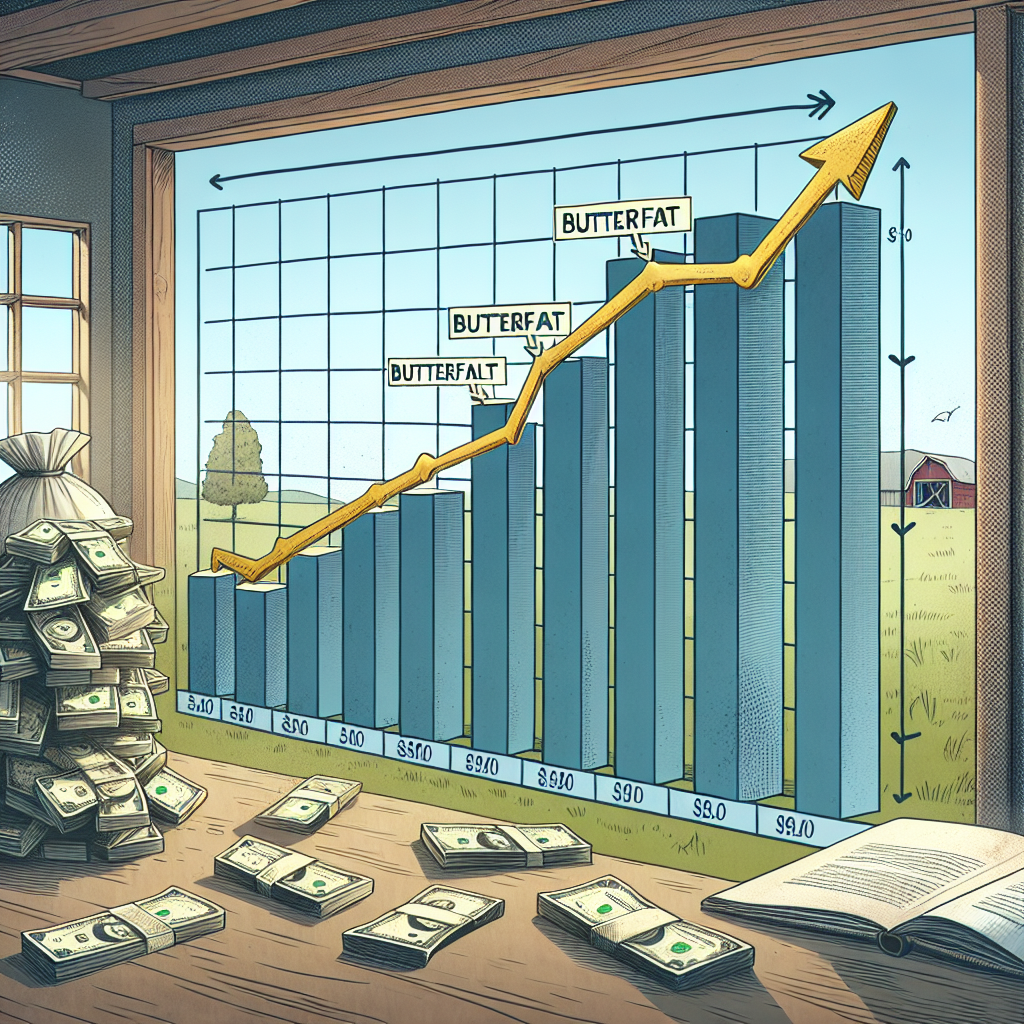New Zealand’s dairy industry is breaking records, but at what cost? As milk production soars and prices hit new highs, farmers face a complex reality of rising expenses and environmental challenges. Discover how Kiwi dairy farmers are navigating this boom and what it means for the future of global dairy markets.
Summary:
New Zealand’s dairy industry is experiencing a remarkable surge, with milk production reaching 5.84 billion pounds in December 2024, up 1.4% from the previous year. Fonterra’s estimated pay price of $9.50-$10.50/kg of milk solids could set a new record. However, this boom comes with significant challenges. Rising input costs, including feed, fertilizer, and fuel, are eroding profit margins despite high milk prices. Environmental pressures and potential shifts in Chinese demand add further complexity. Farmers are urged to focus on cost management, efficiency, and sustainability to navigate these challenges. While the industry contributes 25% to New Zealand’s export earnings, balancing profitability with sustainability remains crucial for long-term success in an evolving global market.
Key Takeaways:
- Understand cost of production (COP) thoroughly to make informed decisions on feed purchases and process extensions.
- Sustainability is vital: adopting eco-friendly practices can secure long-term profitability and market access.
- Keep abreast of Chinese market trends and adjust export strategies to avoid over-dependence.
- Invest in technologies that enhance productivity while containing costs for increased efficiency.
- Develop strategies for financial resilience to withstand global market volatility and rising operational expenses.

New Zealand’s dairy industry is making headlines with Record-breaking milk production and the subsequent rise in milk prices. However, while the numbers look promising, the challenges of increasing production costs (COP), inflation, and environmental issues make the reality more complicated for farmers. Increasing production expenses, inflation, and ecological obstacles indicate that high incomes may not result in significant profits. Let’s explore what this boom means for farmers.
Record-breaking milk production and rising milk prices
| Year | Milk Production (billion pounds) | Milk Solids (million pounds) | Fonterra Pay Price ($/kg MS) |
|---|---|---|---|
| 2023 | 5.76 | 568.5 | 8.00 – 9.00 |
| 2024 | 5.84 | 576.5 | 9.50 – 10.50 |
New Zealand milk production reached 5.84 billion pounds in December 2024, up 1.4% from December 2023, marking the highest volume for the month since 2020. Milk solids also increased by 1.4% year-over-year to 576.5 million pounds, with solids for the 2024-25 season up 3.7% compared to the previous year.
Fonterra, New Zealand’s largest dairy cooperative, recently raised its estimated pay price to $9.50-$10.50/kg of milk solids for the 2024-25 season. If realized, this would be among the highest payouts ever recorded for Kiwi producers.
While these figures highlight strong market performance, Many farmers note that despite high milk prices, the increasing costs of production and environmental challenges often negate the expected profits, highlighting their complex financial realities.
Rising Costs of Production: The Profitability Challenge
| Input Cost | 2020 Price | 2024 Price | % Increase |
|---|---|---|---|
| Feed | $398/ton | $439/ton | 10.3% |
| Fertilizer | $578/ton | $585/ton | 1.2% |
| Fuel | $1.16/liter | $1.91/liter | 64.7% |
Despite high milk prices, farmers are grappling with rising input costs. Feed, fertilizer, fuel, and labor expenses have all increased sharply due to global inflation and supply chain disruptions. Recent estimates suggest that breakeven milk prices for intensive systems now exceed $6.50/kgMS, leaving little room for profit even with record payouts.
One farmer shared their perspective:
“We’re nowhere near the profitability we saw pre-COVID. Input costs are insane right now, so margins are tight even with these high prices.”
This highlights a critical issue: profitability is not just about income but also about effectively managing costs, which has become increasingly difficult in recent years.
China’s Influence on Demand
New Zealand maintains its dominance in China’s dairy market, boasting a 90% market share for whole milk powder (WMP) imports, as reported by recent trade data. Chinese demand has rebounded due to dwindling domestic milk powder inventories and a declining milking herd. This has helped push WMP prices above $4,000/MT, their highest level over two years.
However, there are concerns about how sustainable this demand will be. China is investing heavily in its domestic dairy industry to reduce reliance on imports, which could impact New Zealand’s export opportunities in the long term. While Chinese demand is strong, New Zealand farmers should prepare for potential shifts as China ramps up its domestic production capabilities.
Global Dairy Trade Performance
The Global Dairy Trade (GDT) auctions have reflected strong demand for New Zealand products. Although WMP prices eased slightly in December and early January, they rebounded at the GDT auction on January 21, 2025, and again at GDT Pulse events. WMP prices now sit at $4,000/MT, while skim milk powder prices have also risen.
While these price levels are promising, farmers are cautious about over-reliance on short-term market trends, recognizing the importance of addressing long-term challenges like increasing production costs (COP) and market volatility for sustained profitability.
Environmental Challenges: Balancing Profitability and Sustainability
The environmental impact of intensified dairy farming is another significant challenge facing New Zealand’s industry. Agriculture accounts for nearly half of the country’s greenhouse gas emissions, with dairy farming being a major contributor.
Farm nitrate leaching has led to widespread water quality issues across New Zealand, resulting in the implementation of stringent environmental regulations that not only raise costs for farmers but also endanger ecosystems.
Farmers are under increasing pressure to adopt sustainable practices—not just because they are suitable for the environment but also because they are becoming essential for market access and long-term profitability. Investing in sustainability can help farmers future-proof their operations while meeting regulatory requirements and consumer expectations.
Implications for Farmers: Be Strategic
Given the contradictory conditions of high prices and escalating costs, farmers should adopt strategic approaches, such as diversifying income sources, optimizing resource utilization, and exploring sustainable practices to mitigate financial risks and maximize profitability. Blanket recommendations like “buy more feed” or “extend lactation periods” don’t work for every operation because every farm’s financial situation is unique.
Consider the following considerations for farmers navigating these conditions:
- Know Your Costs: Before making decisions like purchasing supplemental feed or extending lactation periods, calculate your cost of production (COP, which includes all expenses related to production) to ensure it is financially viable.
- Focus on Efficiency: Invest in technologies or practices that improve productivity without significantly increasing costs.
- Monitor Global Trends: Keep an eye on Chinese demand and GDT auction results but remain cautious about over-reliance on export markets.
- Plan for Volatility: Build financial resilience by setting aside reserves during profitable periods to weather future downturns.
- Sustainability Matters: As environmental regulations tighten, adopting sustainable practices now can help future-proof your farm.
Industry Impact and Future Outlook
While current conditions present opportunities for income growth, profitability remains challenging due to the dual factors of rising costs and market uncertainties. The New Zealand dairy sector contributes around 25% to the country’s total merchandise export earnings, highlighting its economic importance and susceptibility to global market changes.
Environmental pressures loom large over the industry as consumers and regulators demand more sustainable practices. Balancing profitability with sustainability will be critical as New Zealand navigates this period of growth.
The Bottom Line
New Zealand’s dairy boom is a double-edged sword: while high production and prices create opportunities for income growth, rising input costs and inflation mean profitability remains elusive for many farmers. As global markets evolve and environmental challenges mount, Kiwi farmers are at a critical juncture where they must balance seizing opportunities with fulfilling their responsibilities.
This isn’t just about acknowledging record figures—it’s about understanding how those numbers directly impact farmers’ financial well-being. By prioritizing efficiency, sustainability, and strategic decision-making, New Zealand’s dairy industry can effectively navigate these challenges and build a more resilient future.
What are your thoughts? Can high milk prices offset rising costs on your farm? Share your experiences and strategies in the comments below to continue this conversation!
Learn more:
- Dairy Sector Debt Surges: Building Resilience amidst Rising New Zealand Dairy Farming Costs and Low Milk Prices
- Global Dairy Market Trends July 2024: Australia’s Rise as Argentina and New Zealand Face Challenges
- Australia’s Dairy Farmers Struggle as Major Processors Slash Milk Prices by 15%
 Join the Revolution!
Join the Revolution!
Bullvine Daily is your essential e-zine for staying ahead in the dairy industry. With over 30,000 subscribers, we bring you the week’s top news, helping you manage tasks efficiently. Stay informed about milk production, tech adoption, and more, so you can concentrate on your dairy operations.







 Join the Revolution!
Join the Revolution!







